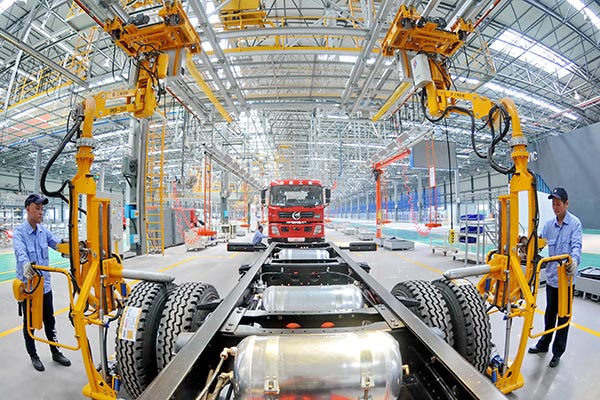China is the world’s largest emerging market economy, both in terms of population and total economic product. The country is arguably the world’s most important manufacturer and industrial producer, and those two sectors alone account for more than 40% of China’s gross domestic product, or GDP. China is also the world’s largest exporter and the second largest importer, and it contains the fastest-growing consumer market. Major industries include manufacturing, agriculture and telecommunication services. As of 2015, the Asian giant is among the most important economic powers on a global scale. It was not always this way, however, and as little as 50 years ago, China was a struggling nation of extreme hunger, poverty and repression.
China’s communist government began to institute capitalist market reforms in 1978, and over subsequent years, the Chinese have taken a sharp turn away from state-owned enterprises, or SOEs. As of 2013, SOEs only accounted for 45% of all Chinese industrial output. That figure was nearly 80% in 1978; the remaining 22% were “collectively owned” enterprises. The result is an economic explosion that catapulted China to the second largest economy in the world, trailing only the United States.
Between 1978 and 2008, the size of the Chinese economy multiplied nearly 50 times over, and average annual GDP growth was approximately 10%. The initial reforms focused on agriculture but soon spread to the services and light manufacturing sectors. All of these were precursors to banking reforms, which led to perhaps the most important transformations in the Chinese economy in the 20th century.>

1. Manufacturing
China makes and sells more manufacturing goods than any other country on the planet. The range of Chinese goods includes iron, steel, aluminum, textiles, cement, chemicals, toys, electronics, rail cars, ships, aircraft and many other products. As of 2015, manufacturing is the largest and most diverse sector in the country.
China is a world leader in many types of goods. For example, almost 80% of all air conditioner units are created by Chinese businesses. China manufactures more than 45 times as many personal computers per person than the rest of the world combined. It is also the biggest producer of solar cells, shoes, cellphones and ships.
Though it does not receive the same kind of credit as Sweden, Germany, Japan or the U.S., China has a thriving automobile manufacturing industry. Most investors are surprised to learn China is the world’s third-largest car manufacturer, though the Chinese government claims it is the world leader.

The Chinese car industry grew out of a national focus on automobiles in the 1990s, a decade when Chinese manufacturers nearly tripled total car output. Though car consumption eventually caught up after 2005, most of these early cars were destined for the export markets because the vast majority of Chinese citizens were too poor to purchase the products themselves.
This is a common theme in the Chinese manufacturing sector. Products are frequently churned out for government use or are immediately put on boats and shipped to foreign consumers. Compared to other nations, Chinese workers historically buy relatively little of their own high-end manufactured products, which is a problem exacerbated when the government devalues the Chinese currency, having the effect of lowering real Chinese wages.
2. Services
As of 2013, only the United States and Japan boasted a higher services output than China, which represents a significant shift for the country. A healthy services sector is a sign of healthy domestic consumption and per capita wealth increases; in other words, the Chinese people are gaining the capacity to afford their own output.
A 2010 world study found the services sector accounted for 43% of total Chinese production, slightly less than its manufacturing sector. However, there are still more Chinese employed in agriculture than in services, which is a rarity for more developed countries.
Before economic reform in 1978, shopping malls and private retail markets did not exist in China. As of 2015, however, there is a young and burgeoning services market. This has bolstered tourism and led to a proliferation of Internet and phone products.

Large foreign companies, such as Microsoft and IBM, have even entered the Chinese service markets. These kinds of moves help to jumpstart the telecommunications industry, cloud computing and e-commerce.
3. Agriculture
Another area where the Chinese set the global standard is in agriculture. There are nearly 300 million Chinese farmers, larger than the entire population of every country except China, India and the U.S. Rice is the dominant agricultural product in China, but the country is also very competitive in wheat, tobacco, potatoes, peanuts, millet, pork, fish, soybeans, corn, tea and oilseeds. Farmers also export large amounts of vegetables, fruits and novel meats to nearby countries and regions, Hong Kong in particular.
As productive as the aggregate agricultural industry in China is, comparative statistics show that Chinese farms are among the least productive in the world on a per capita basis. Some analysts attribute this, in part, to unfavorable climate. Yet, a 2012 Deutsche Bank study concluded that South Korean farmers are 40 times more productive than Chinese farmers despite facing similar topographical and environmental conditions.
Others point to a large degree of state control over Chinese farms as the problem. Farmers are not allowed to own and mortgage farmland and cannot get credit to purchase better capital equipment, two functions which promote innovation and development.

Up and Coming Industries
The 12th five-year economic plan by the Chinese government for the fiscal years 2011-2015 identifies seven strategic industries as high priority: biotechnology, information technology, new energy, environmental maintenance, new materials, high-end manufacturing and alternative fuels. Large government investments are being made into these areas.
One industry not identified but worthy of note is the Chinese health care sector. The rise of middle-class households and urbanization has sparked a huge demand for health care services, which is a hopeful sign for a developing economy. Reforms were passed in 2011 to allow competition into the health care market, including wholly foreign-owned entities. This drew investment from major international players such as Pfizer, Merck and GlaxoSmithKline. China boasts one of the fastest-growing health care sectors in the world.


